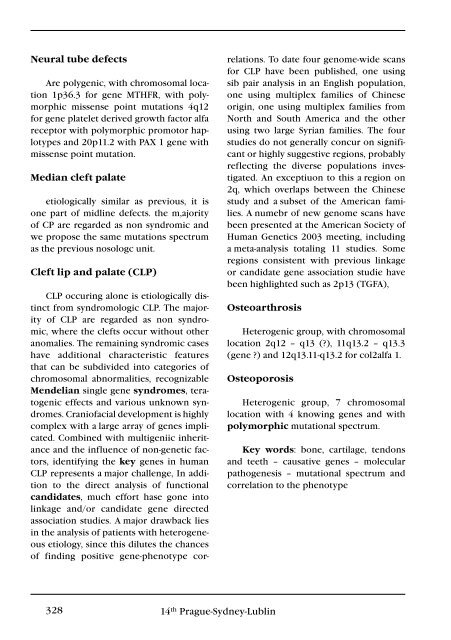3+4+Supplementum/2012 - Společnost pro pojivové tkáně
3+4+Supplementum/2012 - Společnost pro pojivové tkáně
3+4+Supplementum/2012 - Společnost pro pojivové tkáně
- TAGS
- www.pojivo.cz
Create successful ePaper yourself
Turn your PDF publications into a flip-book with our unique Google optimized e-Paper software.
neural tube defects<br />
Are polygenic, with chromosomal location<br />
1p36.3 for gene MTHFR, with polymorphic<br />
missense point mutations 4q12<br />
for gene platelet derived growth factor alfa<br />
receptor with polymorphic <strong>pro</strong>motor haplotypes<br />
and 20p11.2 with PAX 1 gene with<br />
missense point mutation.<br />
Median cleft palate<br />
etiologically similar as previous, it is<br />
one part of midline defects. the m,ajority<br />
of CP are regarded as non syndromic and<br />
we <strong>pro</strong>pose the same mutations spectrum<br />
as the previous nosologc unit.<br />
Cleft lip and palate (ClP)<br />
CLP occuring alone is etiologically distinct<br />
from syndromologic CLP. The majority<br />
of CLP are regarded as non syndromic,<br />
where the clefts occur without other<br />
anomalies. The remaining syndromic cases<br />
have additional characteristic features<br />
that can be subdivided into categories of<br />
chromosomal abnormalities, recognizable<br />
Mendelian single gene syndromes, teratogenic<br />
effects and various unknown syndromes.<br />
Craniofacial development is highly<br />
complex with a large array of genes implicated.<br />
Combined with multigeniic inheritance<br />
and the influence of non-genetic factors,<br />
identifying the key genes in human<br />
CLP represents a major challenge, In addition<br />
to the direct analysis of functional<br />
candidates, much effort hase gone into<br />
linkage and/or candidate gene directed<br />
association studies. A major drawback lies<br />
in the analysis of patients with heterogeneous<br />
etiology, since this dilutes the chances<br />
of finding positive gene-phenotype cor-<br />
328 14 th Prague-Sydney-Lublin<br />
relations. To date four genome-wide scans<br />
for CLP have been published, one using<br />
sib pair analysis in an English population,<br />
one using multiplex families of Chinese<br />
origin, one using multiplex families from<br />
North and South America and the other<br />
using two large Syrian families. The four<br />
studies do not generally concur on significant<br />
or highly suggestive regions, <strong>pro</strong>bably<br />
reflecting the diverse populations investigated.<br />
An exceptiuon to this a region on<br />
2q, which overlaps between the Chinese<br />
study and a subset of the American families.<br />
A numebr of new genome scans have<br />
been presented at the American Society of<br />
Human Genetics 2003 meeting, including<br />
a meta-analysis totaling 11 studies. Some<br />
regions consistent with previous linkage<br />
or candidate gene association studie have<br />
been highlighted such as 2p13 (TGFA),<br />
Osteoarthrosis<br />
Heterogenic group, with chromosomal<br />
location 2q12 – q13 (?), 11q13.2 – q13.3<br />
(gene ?) and 12q13.11-q13.2 for col2alfa 1.<br />
Osteoporosis<br />
Heterogenic group, 7 chromosomal<br />
location with 4 knowing genes and with<br />
polymorphic mutational spectrum.<br />
key words: bone, cartilage, tendons<br />
and teeth – causative genes – molecular<br />
pathogenesis – mutational spectrum and<br />
correlation to the phenotype

















